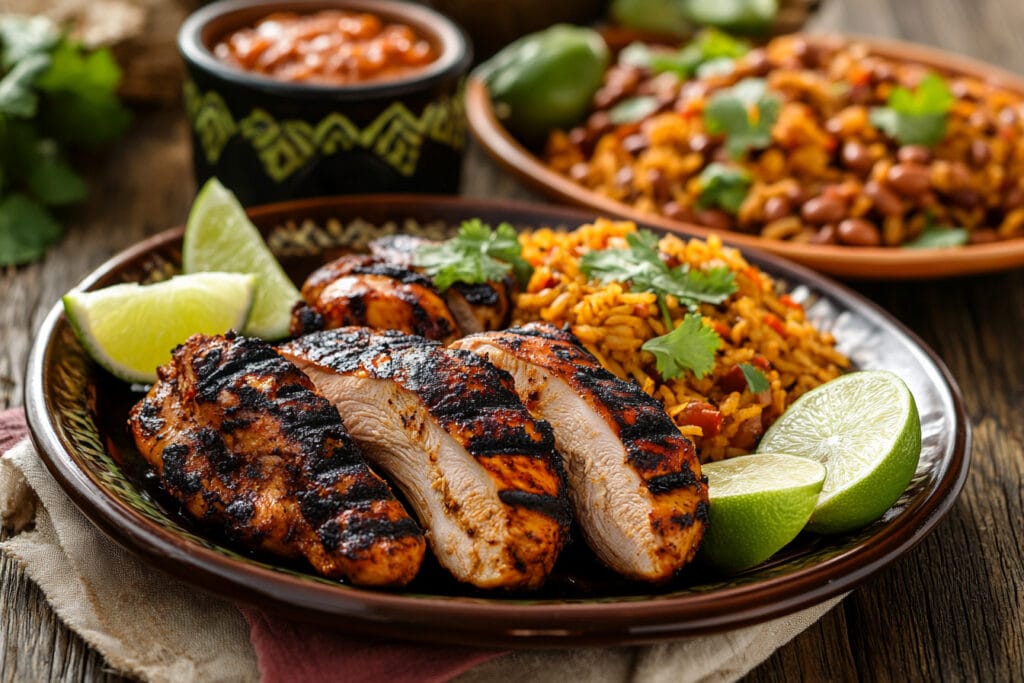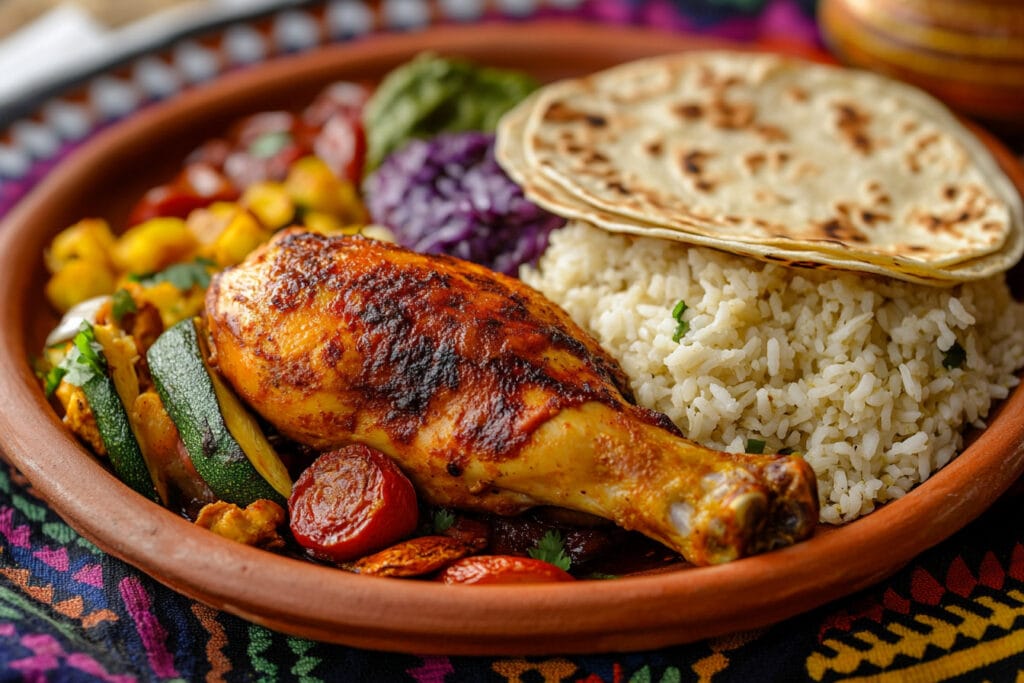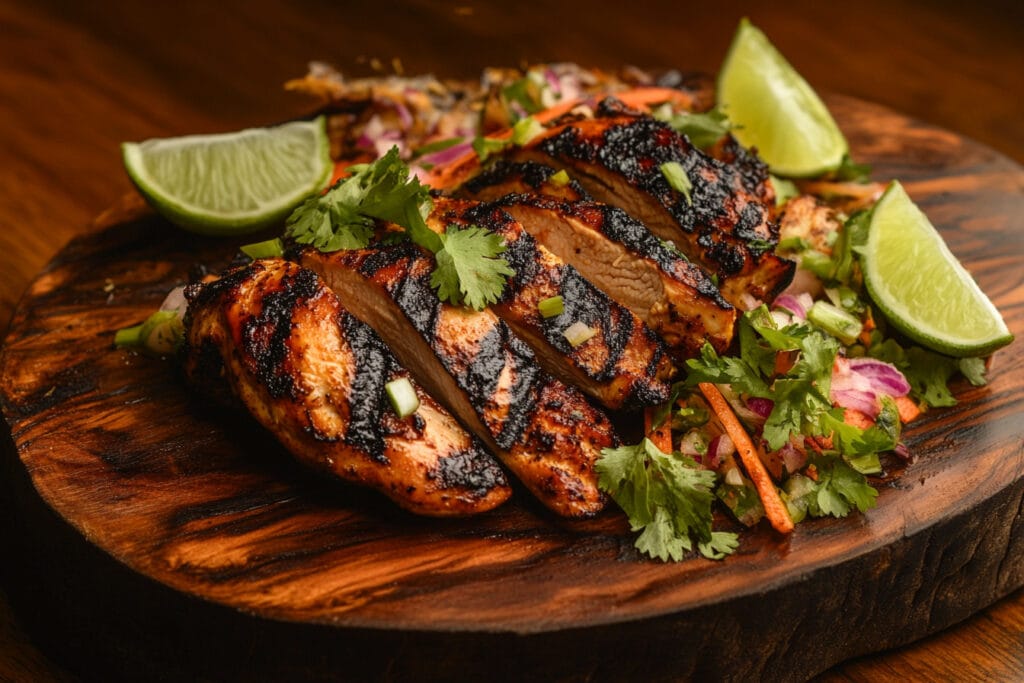
Pollo Asada and Pollo Asado are two famous chicken dishes from Latin American cuisine. The names sound similar, but the cooking styles and flavors are different. Pollo Asado means “roasted chicken,” while Pollo Asada means “grilled chicken.” The way they are prepared gives each dish a unique taste.
This guide will explain what makes them different. You’ll learn about their origins, cooking methods, and when to choose each one. If you love chicken and want to explore new dishes, keep reading!
What is Pollo Asado?
Pollo Asado is a dish that means “roasted chicken.” It comes from many Latin American and Spanish traditions. The chicken is marinated in a mix of spices, citrus juice, and herbs. Then, it is roasted or grilled slowly. This cooking style makes the chicken juicy and full of flavor.
Key Ingredients in Pollo Asado
Pollo Asado stands out for its bold and zesty flavors, which come from its marinade. Some of the common ingredients include:
- Citrus juices: Lime, lemon, or orange juice adds a tangy and refreshing flavor.
- Garlic and onion: These provide a savory base for the marinade.
- Herbs and spices: Cumin, oregano, paprika, and chili powder are often used to enhance the flavor.
- Achiote paste: This is a common ingredient in Mexican Pollo Asado, giving the dish its vibrant color and slightly earthy taste.
Popular Dishes Using Pollo Asado
Pollo Asado is not just served as a standalone dish. It’s often incorporated into other delicious recipes, such as:
- Tacos de Pollo Asado: Grilled chicken tacos topped with fresh salsa, guacamole, and a squeeze of lime.
- Burritos: Pollo Asado is a favorite filling for burritos, paired with rice, beans, and cheese.
- Salads: Sliced Pollo Asado is a great addition to salads for a flavorful protein boost.
- Bowls: Combine Pollo Asado with rice, black beans, and veggies for a hearty meal.
Now that you know what Pollo Asado is, let’s explore Pollo Asada and how it differs!

What is Pollo Asada?
Pollo Asada is another popular chicken dish, but it is often misunderstood or confused with Pollo Asado. While the difference between the two may seem subtle, it lies in the way they are prepared, seasoned, and served. Pollo Asada is all about grilled flavors, vibrant spices, and a distinctive culinary technique that sets it apart.
Marinades and Seasoning for Pollo Asada
The marinade for Pollo Asada is tangy and bold. Some common ingredients include:
- Citrus juices: Lime juice is essential for Pollo Asada.
- Garlic: Adds a savory kick to the marinade.
- Chili peppers: Adds heat and smoky flavor.
- Cilantro: Provides a fresh, herby taste.
- Spices: Cumin, paprika, and black pepper are often used.
The chicken is usually marinated for hours to let the flavors soak in.
Common Dishes Featuring Pollo Asada
Pollo Asada is versatile and can be used in a wide range of dishes that celebrate its grilled, smoky flavors. Here are some popular examples:
- Grilled Pollo Asada Plates: Served with Mexican rice, beans, and tortillas for a traditional meal.
- Fajitas: Sliced Pollo Asada is often used in fajitas, paired with grilled onions and bell peppers.
- Tostadas: Crispy tostadas topped with Pollo Asada, refried beans, lettuce, and salsa.
- Quesadillas: Pollo Asada makes an excellent filling for cheesy quesadillas.
- Sandwiches or Wraps: A Pollo Asada sandwich or wrap is perfect for a quick and flavorful meal.

Comparing Pollo Asada and Pollo Asado
Now that we’ve covered the basics of both Pollo Asada and Pollo Asado, it’s time to compare the two in greater detail. While they might sound similar, their differences lie in their preparation, seasoning, cooking methods, and even cultural contexts. Let’s break it all down!
Literal Translation and Language Differences
One of the most obvious differences lies in the name.
- Pollo Asado: Translates to “roasted chicken.” The term emphasizes a cooking style that involves slow roasting or grilling over moderate heat.
- Pollo Asada: Translates to “grilled chicken.” While similar to Pollo Asado, it emphasizes grilling, typically over higher heat, to achieve a charred and crispy exterior.
The difference in the word endings (“-ado” vs. “-ada”) comes from Spanish grammar. In Spanish, adjectives like “asado/asada” must agree with the gender of the noun they describe. Because “pollo” (chicken) is masculine, the correct form in most cases is “asado.” However, some regions or speakers may use “asada” interchangeably. So while the terms are grammatically different, they’re often used to describe similar dishes.
Cooking Techniques: Grilling vs. Roasting
One of the most significant differences between Pollo Asado and Pollo Asada is the cooking technique:
- Pollo Asado: Typically involves slow roasting or grilling over medium heat. The chicken is often cooked whole or in large pieces, allowing the meat to stay tender and moist. Roasting can be done in an oven, on a rotisserie, or over a flame.
- Pollo Asada: Specifically grilled over high heat to achieve a slightly charred exterior. The chicken is often cut into smaller pieces, like thighs, breasts, or wings, for quicker cooking and better grill marks.
Key Takeaway: If you want smoky and tender chicken, go for Pollo Asado. If you prefer crispy, charred, and slightly smoky chicken, Pollo Asada is the way to go.
Flavors and Seasoning Profiles
While both dishes use flavorful marinades, their seasonings can differ depending on the regional variations and cooking methods:
- Pollo Asado:
- Typically uses a marinade that includes citrus juices, garlic, oregano, and paprika.
- In Mexican cuisine, achiote paste is a common ingredient, giving the dish its bright orange color and slightly earthy taste.
- The flavors are bold but balanced, with an emphasis on juicy and tender meat.
- Pollo Asada:
- The marinade is often more tangy and smoky, emphasizing lime juice, cumin, chili peppers, and cilantro.
- The high-heat grilling process enhances the smoky flavors, giving the dish a charred, crispy texture.
- It’s a little more intense in flavor due to the high-heat cooking process.
Key Takeaway: Pollo Asado is all about tender and juicy meat with balanced flavors, while Pollo Asada leans toward bold, tangy, and smoky notes with a crispy finish.
Regional Variations and Cultural Differences
Both dishes have regional influences that make them unique:
- Pollo Asado:
- Popular across Latin America, with variations in Mexico, Puerto Rico, and Cuba.
- In Mexico, Pollo Asado is often prepared with achiote paste and cooked on a rotisserie.
- In Cuba, the marinade tends to feature sour orange juice and garlic for a distinctive Cuban twist.
- Pollo Asada:
- More commonly associated with Mexican grilling traditions.
- Often prepared for outdoor gatherings, family barbecues, and street food stands.
- The dish celebrates the art of grilling and is a staple in many casual Mexican meals.
Visual and Textural Differences
- Pollo Asado: Typically has a smoother, juicier appearance, with a roasted or lightly grilled exterior. The meat is tender, often falling off the bone if slow-roasted.
- Pollo Asada: Features grill marks, a slightly crisped skin, and a smoky, charred appearance. The meat is firmer but still juicy inside.
Which Should You Choose?
When deciding between Pollo Asada and Pollo Asado, it often depends on your personal preferences and the meal you’re planning. Here’s a quick guide:
- Choose Pollo Asado if:
- You prefer tender, juicy chicken with balanced seasoning.
- You’re making a dish that requires slow cooking or roasting.
- You want to enjoy a traditional Latin American-style roasted chicken.
- Choose Pollo Asada if:
- You love smoky, charred flavors with a tangy twist.
- You’re grilling outdoors or want a crispy exterior.
- You’re making tacos, fajitas, or other grilled dishes.
Both are delicious and versatile dishes that highlight the best of Latin American culinary traditions!
Why Does the Difference Matter?
Understanding the difference between Pollo Asada and Pollo Asado goes beyond just knowing how they’re cooked. These two dishes represent more than just culinary techniques – they reflect cultural traditions, regional tastes, and even personal preferences when it comes to food. Let’s explore why these differences matter and how they can affect your choice in the kitchen or at the dining table.
How to Choose Between Pollo Asada and Pollo Asado for Meals
The choice between Pollo Asada and Pollo Asado depends on a few factors, including the meal you’re planning, your taste preferences, and the cooking equipment available to you.
- For Casual Meals:
- If you’re making tacos, burritos, or fajitas, Pollo Asada is your best bet. The grilled chicken’s smoky and tangy flavors pair perfectly with fresh salsa, guacamole, and tortillas.
- It’s also a great choice for outdoor barbecues or quick dinners that don’t require long cooking times.
- For Traditional or Festive Dishes:
- When cooking for a more formal gathering or a traditional family meal, Pollo Asado is a great choice. The tender, roasted chicken is ideal for serving alongside rice, beans, or roasted vegetables.
- The slow-cooking process also allows for larger portions, making it perfect for feeding a crowd.
- Equipment Matters:
- If you have a grill, Pollo Asada is the natural choice, as the high heat and smoky flavor are essential to the dish.
- If you have an oven or rotisserie setup, Pollo Asado will work better, as these methods allow for even cooking and juicy results.
Key Takeaway: Think about your cooking tools and the type of meal you’re planning to make the right choice.
Fun Facts About Pollo Asada and Pollo Asado
- They’re Not Always Chicken!
- While “pollo” means chicken, some variations of these dishes use other meats, like pork or beef, but they retain the “asado/asada” name to describe the cooking style.
- Street Food Stars:
- Pollo Asada is a common star in Mexican street food culture, where it’s often sold as freshly grilled tacos or served alongside grilled corn and vegetables.
- Pollo Asado in Fast Food:
- Pollo Asado has gained popularity in fast-food chains, especially in the United States, where it’s featured in burritos, bowls, and salads.
- Family Recipes Vary Greatly:
- There’s no one “official” way to make Pollo Asado or Pollo Asada. Family recipes often include unique marinades, secret spices, or cooking tricks that make each dish special.
- Achiote’s Role in Pollo Asado:
- Achiote, a reddish spice paste used in Pollo Asado, comes from annatto seeds. It not only adds color but also provides an earthy flavor.
- Grilling Is a Social Event:
- In many Latin American countries, grilling Pollo Asada is more than cooking – it’s a way to bring family and friends together for celebrations or casual get-togethers.
Why Knowing the Difference Can Improve Your Cooking
If you’re a budding chef or a food enthusiast, understanding the differences between Pollo Asada and Pollo Asado can elevate your cooking. Each dish uses different techniques, ingredients, and flavors, which can inspire you to experiment in the kitchen.
- Learn New Cooking Skills: Mastering grilling for Pollo Asada or roasting for Pollo Asado can make you a more versatile cook.
- Expand Your Taste Palate: By trying both dishes, you’ll develop an appreciation for the subtle differences in flavor profiles.
- Celebrate Cultural Heritage: Cooking these dishes allows you to explore the rich culinary traditions of Latin America and share them with others.
Frequently Asked Questions (FAQs)
To help clarify any lingering questions you might have about Pollo Asada and Pollo Asado, here are some common FAQs that dive deeper into their differences, preparation, and culinary uses.
What are the main differences between Pollo Asado and Pollo Asada?
The primary differences lie in the cooking method and seasoning:
- Pollo Asado: Generally roasted or slow-grilled, resulting in tender and juicy meat with balanced flavors. Learn more about the distinctive preparation methods of Pollo Asado in this guide to juicy and flavorful Pollo Asado.
- Pollo Asada: Grilled over high heat, giving it a smoky, charred exterior and bolder, tangier flavors. Additionally, the linguistic difference (-ado vs. -ada) is more of a grammatical distinction in Spanish, not a significant culinary variation.
Which is healthier: Pollo Asado or Pollo Asada?
Both dishes are healthy options since they utilize lean chicken and rely on marinades instead of heavy sauces. However:
- Pollo Asado: Cooking methods like roasting or slow grilling use less oil, which can make it a lighter option. For an example, explore how Pollo Asado retains its moisture during roasting or grilling in this Pollo Asado recipe.
- Pollo Asada: High-heat grilling might require a light coating of oil to prevent sticking. However, the process can reduce fat content as excess grease drips off.
The healthiness depends on the marinade and side dishes. Both dishes are high in protein and can be part of a balanced meal.
Can Pollo Asado and Pollo Asada be cooked the same way?
Technically, yes, but flavors and textures may vary:
- Pollo Asada: Roasting it might reduce its smoky, charred flavor that high-heat grilling provides.
- Pollo Asado: Grilling it might not produce the same tender texture achieved with slow roasting.
For authentic Pollo Asado techniques, consider checking this comprehensive Pollo Asado cooking guide.
Are the ingredients always the same?
Not necessarily. Base ingredients like citrus, garlic, and spices overlap, but the marinades diverge:
- Pollo Asado: Often includes achiote paste, paprika, and oregano, contributing to its vibrant hue and balanced flavor. See how achiote and other spices enhance this Pollo Asado recipe.
- Pollo Asada: Emphasizes tangier flavors like lime juice, chili peppers, and cilantro for a smoky, grilled taste.
Which tastes better: Pollo Asado or Pollo Asada?
It depends on personal preference:
- Pollo Asado: Offers tender, juicy chicken with mild yet flavorful seasoning.
- Pollo Asada: Bold, tangy flavors with a smoky, crispy exterior.
Both are delicious in their own right! Try this Pollo Asado recipe to compare for yourself.
Where can I find authentic Pollo Asado or Pollo Asada?
You can enjoy authentic dishes at:
- Local Mexican Restaurants: Look for Pollo Asado served with traditional sides like rice and beans.
- Street Food Stalls: Especially for smoky Pollo Asada.
- Homemade Recipes: Recreate Pollo Asado by following this easy and flavorful recipe.
Can I use the same marinade for both dishes?
Yes, the marinades can overlap, but cooking methods affect the flavor:
- Pollo Asado Marinades: Often incorporate achiote for a slow-roasting style.
- Pollo Asada Marinades: Highlight tangy ingredients like lime juice, ideal for grilling.
For a versatile marinade that works for both, check out this detailed Pollo Asado recipe.
Conclusion
Pollo Asada and Pollo Asado are both delicious chicken dishes. Pollo Asado focuses on tender, roasted flavors, while Pollo Asada highlights smoky, grilled tastes. Choosing between them depends on your meal and flavor preference. Both are easy to make and perfect for trying at home. Enjoy the best of Latin American cooking with these tasty dishes!
